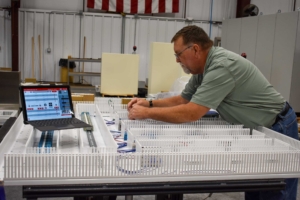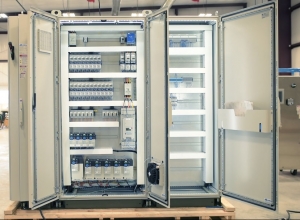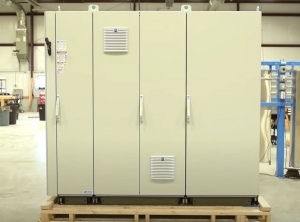UL markers are most seen on industrial equipment and home appliances. These include furnaces, fuses, electrical panels, circuit breakers, and thousands of other products. Industrial Control Equipment is no exception. Virtually all cities and states require a third-party inspection of industrial control panels before those panels can be powered up. The requirements for testing by third-party inspection are based on section 1910.303 of OSHA. This assures that the panel will operate safely and will not cause shock or fire.  To earn the right to put UL-certified stickers on industrial control panels; procurement, production processes, and finished panels, must undergo examination and inspection on a regular basis.
To earn the right to put UL-certified stickers on industrial control panels; procurement, production processes, and finished panels, must undergo examination and inspection on a regular basis.
NorthWind Technical Services is a certified Industrial Control Panel manufacturer. NorthWind Technical Services is proud to be UL508A certified since 2005, and UL698A since December 2020. Customers have come to value the quality of panels that NorthWind provides, and the UL Certification guarantees not only quality, but a high level of workmanship, trained personnel, and a documented quality control process. (Anderson, T., NorthWind Technical Services Quality Control).
What does it mean to be UL Certified?
UL (Underwriter Laboratories) was founded in 1894 in Chicago. UL is a third-party certification company, a safety organization, that sets industry-wide standards, ensuring that products are constructed correctly for the highest level of safety. UL certifies products with the aim to make the world a safer place for both workers and consumers (ul.org).
A common misconception is that UL tests every product themselves. This is not always the case. Instead, UL authorizes a manufacturer to test the product themselves using the UL stamp. UL then follows up on a regular basis to make sure that the products are being tested, following proper safety guidelines (www.ul.com). This is one of many reasons that UL certification is attractive to businesses.
Although the UL stamp is very recognizable, there is not a general UL seal of approval (ul.org). Instead, to obtain UL certification, there are three distinct categories of approval.

UL recognition is for components and UL Listed is for stand-alone products. While both ensure a set of industry standards, they are used for different products and in different capacities. Therefore, UL Listed is more recognizable to consumers because it ensures the safety of consumer-ready products on the market.
Far more testing is involved in UL Listed certification (ul.org). The UL Listed seal means that the product has been tested by UL to nationally recognized safety and sustainability standards and is free from a reasonably foreseeable risk of fire, electric shock in a Division 2 environment (an area where ignitable concentrations are used).
UL Standards for Industrial Control Panels
UL508 – The primary certification for industrial control equipment is UL 508. UL508 covers industrial control and related devices rated 1500 volts or less used for starting, stopping, regulating, controlling, or protecting electric motors. In accordance with the National Electrical Code, ANSI/NFPA 70, the equipment is intended for installation in ordinary locations where the ambient temperature does not exceed 40°C (104°F) maximum (hightechsafety.com).
UL508A – UL508A is the standard for the construction of industrial control panels, where panel builders have expertise in proper component selection, wiring methods, and circuity calculations. The UL 508A Listing Mark covers industrial control panels with a voltage of 1000 volts or less. The UL508A Listing Mark provides evidence of third-party certification to the municipal inspection authority and to the purchaser of the panel. A UL 508A Listing Mark shows that the panel complies with an acceptable safety standard (hightechsafety.com).
To allow the installer to properly install the panel in accordance with National Electrical Code (NEC) and other codes, electrical ratings and instructions are to be clearly explained on the panel.”
Installation of a control panel can be completed in two ways: in an enclosure as “enclosed type” equipment or arranged onto a mounting panel as “open type” equipment. For “open type” equipment, the assembly is installed in an enclosure provided by others, or at the installation site (hardcore-electric.com).
Enclosures can help mitigate fire hazards, reduce the risk of shock, and minimize other risks that could happen during accidental contact with electrical equipment. The rating of the enclosure will determine if the panel can be inside or outside. The UL Enclosure Rating determines if the panel can be inside or outside (irtrectifier.com). The UL Ratings are as follows:
Type 1- Indoor use to provide a degree of protection against contact with the enclosed equipment and to provide a degree of protection against falling dirt.
Type 2- Indoor use to provide a degree of protection against contact with the enclosed equipment, to provide a degree of protection against falling water dirt, and to provide a degree of protection against dripping and light splashing of non-corrosive liquids.
Type 3- Indoor or outdoor use to provide a degree of protection against contact with the enclosed equipment; to provide a degree of protection against falling dirt, windblown dust, rain, sleet, and snow; and that will be undamaged by the formation of ice on the enclosure.
Type 3R- Indoor or outdoor use to provide a degree of protection against contact with the enclosed equipment; to provide a degree of protection against falling dirt, rain, sleet, and snow; and that will be undamaged by the formation of ice on the enclosure.
Type 3S- Indoor or outdoor use to provide a degree of protection against contact with enclosed equipment, to provide a degree of protection against falling dirt, windblown dust, rain, sleet, and snow; and in which the external mechanisms remain operable while ice laden.
Type 4- Indoor or outdoor use to provide a degree of protection against contact with enclosed equipment, to provide a degree of protection against falling dirt, splashing water, windblown dust, rain, sleet and snow, and hose-directed water; and that will be undamaged by the formation of ice on the enclosure.
Type 4X- Indoor or outdoor use to provide a degree of protection against contact with enclosed equipment, to provide a degree of protection against falling dirt, splashing water, windblown dust, rain, sleet and snow, and hose-directed water, and corrosion; and that will be undamaged by the formation of ice on the enclosure.
Type 5- Indoor use to provide a degree of protection against contact with enclosed equipment, to provide a degree of protection against falling dirt, settling airborne dust, lint, fibers, and flyings; and to provide a degree of protection against dripping and light splashing of non-corrosive liquids.
Type 6- Indoor or outdoor use to provide a degree of protection against contact with enclosed equipment, to provide a degree of protection against falling dirt, rain, sleet, snow, hose-directed water, corrosion, and the entry of water during occasional temporary submersion at a limited depth; and that will be undamaged by the formation of ice on the enclosure.
Type 6P- Indoor or outdoor use to provide a degree of protection against contact with enclosed equipment, to provide a degree of protection against falling dirt, rain, sleet, snow, hose-directed water, corrosion, and the entry of water during prolonged submersion at a limited depth; and that will be undamaged by the formation of ice on the enclosure.
Type 12 – Indoor use (for enclosures without knockouts) to provide a degree of protection against circulating dust, falling dirt, lint, fibers, flyings; and to provide a degree of protection against dripping and light splashing of non-corrosive liquids, and against light splashing and consequent seepage of oil and non-corrosive coolants.
Within the UL 508A standard, there are two sections that are relevant to enclosures and cabinets.The GENERAL section addresses requirements for all panels, and these requirements include:
- Protection Against Corrosion
- Support and Securement of Live Parts
- Spacings
- Conduit Bushings
- Insulating Barriers
- Insulating Materials
- Grounding – General
- Grounding – Size of Terminal or Bonding Conductor
- Identification of Grounding and Grounded Circuit Conductors and Terminals
The ENCLOSURE section contains requirements for enclosures, addressing items such as:
- Enclosure Openings
- Accessibility of Live Parts
- Ventilation Openings
- Bonding
- Observation Windows
- Enclosure Environmental Control Devices
- Enclosure Maintenance Lighting
To summarize, 508A certification means that components used in the panel design must be from “listed” or “recognized” sources that are certified. UL508A certification ensures the buyer that all components used in the panel design are used in accordance with the requirements of that component (Drew, B., NorthWind Technical Services Project Manager).
UL698A – The UL698A certification governs panels “relating to hazardous locations.” This applies to industrial control panels that are intended to be placed in a safe environment but have circuits that feed out into hazardous environments. The panels do not require explosion proof, dust-proof, or pressurized enclosures, but do require intrinsically safe control circuits. Intrinsic safety is a key consideration of industrial control panel manufacturing for hazardous and unclassified locations, as it directly restricts the availability of energy to unprotected field devices to prevent ignition (www.ul.com).
Explosion-proof and hazardous location panels prevent explosions by containing the blast. These types of panels have robust enclosures to contain the flames and ignite elements inside, preventing damage to surrounding equipment. On the other hand, intrinsically safe control panels prevent ignition from sensors and other unprotected field devices. Intrinsically safe control panels utilize specifically designed wiring and equipment that limits the level of electrical and thermal energy transmitted to a level below what is required to ignite a specific hazardous atmospheric mixture. Limiting the energy levels that passes through wiring and equipment effectively prevents ignitions from occurring (www.ul.com). The UL698A certification allows NorthWind to assemble panels with intrinsic safety barriers for connection to circuits residing in hazardous locations.
What constitutes a hazardous environment?
Hazardous locations are defined by the National Electric Code (NEC), NFPA 70. (www.nfpa.org).
Classes:
- Class I:Denotes areas where flammable gas, vapor, or liquid is present.
- Class II:Denotes areas where combustible dust is present.
- Class III: Denotes areas where ignitable fibers are present. The difference between flammable, combustible, and ignitable all has to do with the different temperatures at which a substance will ignite.
Groups:
- Group A (Class I): Acetylene
- Group B (Class I): Hydrogen
- Group C (Class I): Cyclopropane, ethel ether
- Group D (Class I): Acetone, butane, propane, hexane, natural gas fuel oil.
- Group E (Class II): Combustible metals (e.g., lithium, magnesium, titanium)
- Group F (Class II): Carbonaceous materials (such as coal dust)
- Group G CLASS II): Flour, starch, plastic
The NEC further categorizes areas into three different divisions (www.nfpa.org):
- Division 1: Areas where flammable or combustible concentrations exist under normal circumstances OR are highly likely to exist under other circumstances.
- Division 2: Areas where flammable or combustible concentrations exist under abnormal circumstances OR are not likely to exist under other circumstances.
- Non-classified/Unclassified: Areas where the presence of hazardous material is so infrequent, Electrical Area Classification is deemed unnecessary.
Many of NorthWind’s panels go into Group G (Class II) locations (Anderson, T., NorthWind Technical Services Quality Control).
Are all Industrial Control Panels UL Certified?
Although most Industrial Control panels go through rigorous quality and safety controls, they may not be UL certified. Non-certified panels make up about 80% of the market (www.ul.com). When it comes to control panel safety, the sum can be no better than the parts, and a UL listing for a panel depends, in part, on it being assembled from UL listed components. Many states and counties require UL certification. A few important considerations when choosing a control panel is:
Is the panel made from UL listed components recognized for its specific application?
Is the panel built according to UL standards?
Is the panel verified through onsite inspections that adhere to safety standards?
Summary
NorthWind Technical Services has worked to earn and maintain UL certification, and the UL mark on a NorthWind panel assures the customer that the panel was built in a precise and organized manner, that rigorous quality standards were followed, and critical safety details were not overlooked.
learn more
Advanced Manufacturing

We strive to continuously improve our products & processes. In 2017 we added the panel cutting machine and in 2020 we added the wire processing machine to our Panel Shop. Both of these additions have increased our efficiencies allowing us to deliver quality panels with shorter lead times.
Motor Control Panels
Motor Control Panels are a great alternative to motor control centers. Our innovative design is built with cost saving and safety minded features.



